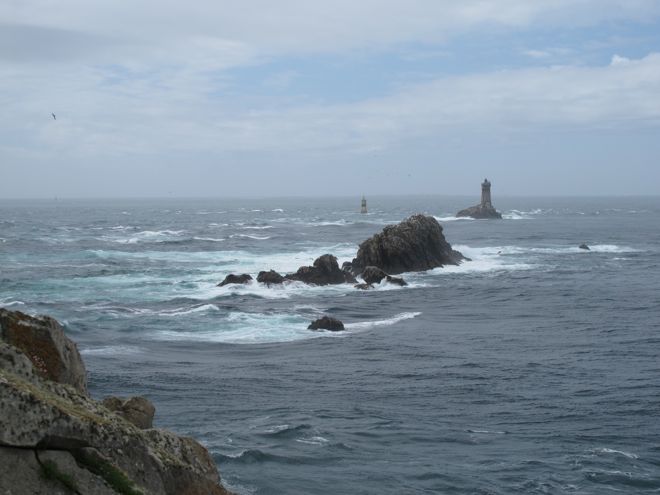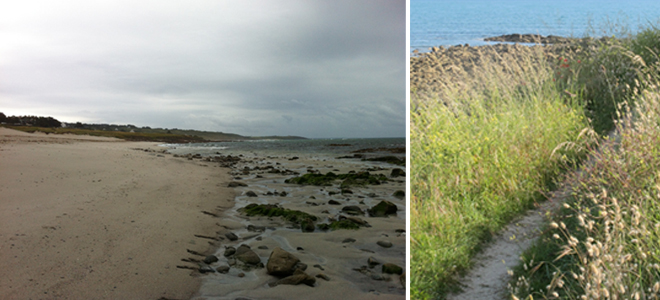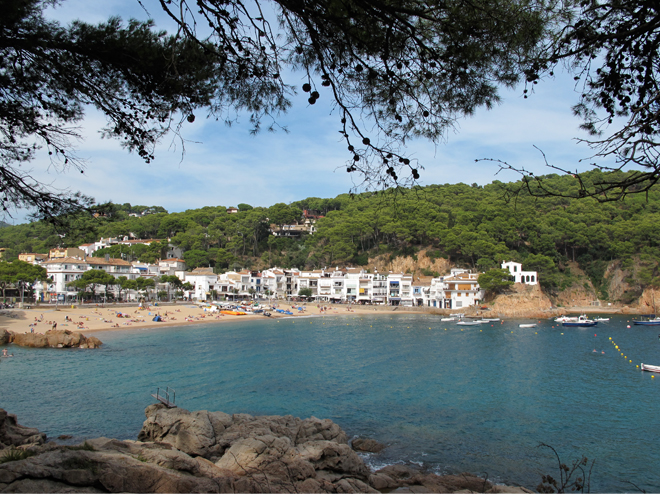

Back and forth, hither and yon – whether on my habitual trajectory between Touraine and Paris or further afield… destinations, encounters, events and observations I can’t resist sharing.

Just back from the department of Finistere on the southwest coast of Brittany. It’s a good thing the scenery is gorgeous because Brittany weather is consistently wet and windy. I did catch 2 sunny beach days at Pont-Aven one summer, but the sea was so cold it gave you a headache. If you thrive on the bracing coastal romance of Maine, Nova Scotia, west of Ireland and Scotland, then Finistere is for you.
The holy grail of windswept scenery is La Pointe du Raz, beyond the village of Plogoff – a rocky promontory notorious with sailors for intimidating waves and deadly currents. Tourists were kitted out in hiking sneakers and anoraks with a hood. It was far too blustery for an umbrella or a rain hat, unless tied tight under the chin (not a winning look even for babies).
Pointe du Raz is France’s Land’s End, and became a major tourist destination after Victor Hugo and Gustave Flaubert extolled its savage beauty. “Here is the end of the old world; behold its outer limit. Over your shoulders lie all of Europe and Asia; in front of you the ocean, the endlesss ocean.**” Technically Flaubert got it wrong, as there are two other Brittany outcroppings that extend a tad further into the Atlantic, but neither has comparably sublime scenery.
When crowds needed to be reined in at the risk of destroying the fragile ecosystem, Raz was designated a protected national park – one of France’s not-to-be-missed “Grand Sites”. Today’s pilgrimage is an orderly, didactic affair involving paid parking, a show-and-tell visitor’s center and jitney bus ride for the tired, infirm, lazy, or anyone who hopes to keep their hair looking good. On a clear day you can spy the low-lying island of Sein, just 5km offshore. Sein is a hardy fishing community with neither cars nor protected harbor, now threatened by rising sea levels. The sea was too rough for ferries to dock the day we were there.
Finistere is the cradle of Basse (or low) Brittany culture. Basse refers to the western half of Brittany, where most locals spoke only Breton before it was outlawed in 1902. An unofficial border has existed since the 14th century between the Basse and Gallo (French speaking) eastern half of Brittany. The Celtic language formerly spoken in the west, is now being revived in bilingual schools throughout the peninsula, and promoted through numerous cultural associations and institutions, yet a mere 5% of the population (206,000*) speak it fluently.

The profile of a typical Bretonnant speaker is a retired married woman with no educational degree living along the Finistere coast. Her husband was likely a fisherman, farmer or manual laborer and chances are that her children understand the language but don’t speak it. Ironically, the generation who speaks fluently is conflicted about Breton’s importance, as their parents (many of whom didn’t speak fluent French) were stigmatized as being primitive. What is now being taught in bilingual schools, and spoken on radio and TV, can be difficult for them to understand, as they speak more of a patois.
The statistical trend isn’t promising for a living language, with less than 2% of school children enrolled in bilingual school and just 3% of parents transmitting it at home. However, the reality of a language in decline hasn’t tarnished its stature as a symbol of regional pride.
We tuned into a Breton station for a few hours, and concluded that it’s unintelligible to French and English speakers. The only word I picked up was the German sounding “Ya” for yes. Breton most closely resembles Welsh, and like Wales, Bretons identify strongly with their traditions. Much of their identification is tied to a mythic past and heroic traits or stereotypes like rugged individualism and connection with nature.
Bretons describe themselves in the third person as independent characters that are stubborn, rebellious, hard working and sensitive. Having grown up in an Irish American family, I recognize the disconnect between talking the talk and walking the walk. If I’d proposed studying Gaelic instead of Latin or French, my parents would have told me to have my head examined. Speaking with a brogue was a stigma, just as having a Breton accent is tied to a lingering sense of inferiority among many elderly Bretonnants.
Unlike the Pays Basque, Brittany isn’t battling for autonomy or the sort of institutional independence Catalonia won in Spain. There’s a stronger sense of community here than in other regions of France, but also less xenophobia. Brittany voters have historically rejected the National Front party and tend to vote Socialist. While the rest of France considers the Brittany peninsula somewhat remote, Brittany has never perceived itself as isolated. The sea has always been its highway and its ports have welcomed visitors from Spain and the British Isles for centuries. It is closer to to England than Paris.

Plouhinec west of Quimper was our second Brittany filming destination. I tested Air BNB and found a modest three-bedroom house overlooking a sandy cove, down the road from the fishing port of Audierne. Stringent coastal zoning no longer permits construction close to the shoreline, but the owners of the house we rented are seeking permission to add on a needed second bathroom on the upper floor. With that addition, I would highly recommend it for two couples or a family with small children. The location, delightful view and price can’t be beat, and for those who enjoy cooking, the kitchen is well equipped. A Franco-British couple owns it and Sue the booking member of the couple and her trusty housekeeper couldn’t be more accommodating. Read More »

Beyond broad beaches of fine sand and gently rolling waves – 3 reasons not to miss this gracious seaside town in the Médoc wine region:
Just when you’re convinced there can’t be more hidden treasure along the Atlantic coast – you hit on a sleeper like Soulac. Why didn’t I know about this place? 100 kms north of Bordeaux and a hop across the Gironde estuary from Royan – it merits better name recognition. Soulac has the architectural potential to be a mini Savannah or South Beach of the French Atlantic coast, yet remains a little known family resort.
Arriving from the north or east, the easiest way to get there is a 30-minute car ferry from Royan. Leave time for a quick tour of the city. Royan is a brilliant white-painted concrete 1950’s time capsule. The old city was obliterated on January 5, 1945 by Allied carpet-bombing intended to annihilate intransigent Nazis. A massive urban renewal project attempted to compensate for thousands of citizens killed due to tragic miscommunication between an American general and the French military concerning evacuation.
A scenic alternate route is up the peninsula via Bordeaux. The winding road along the Gironde Estuary traverses fabled Chateaux vignobles – Margeaux, Latour, Mouton-Rothschild and Lafite – ending in Saint Estèphe, before leaving the undulating Haut Médoc terroir to enter the marshy flatlands of Médoc.
The landscape is a mixture of sand dunes and scrub pines on the ocean side, and marshland along the estuary. The eastern shore is scissor cut with minute tidal ports, where modest pleasure and fishing boats keep company with cabanes de pêcheurs cantilevered over the water on stilts. The most picturesque to my taste is Port de la Maréchale next to St-Seurin-de-Cadourne.

In mid March, Soulac was emerging from winter hibernation. Its population of 3,000 expands July through August to 55,000, but tourist season builds up slowly. My first hotel choice – Hôtels des Pins in Amelie Beach at the southern edge of town – opens in April, so we settled for Hotel Michelet, a small 2 star a block off the oceanfront. The establishment is impeccably clean and professionally run, but shrill décor, circa 1995, is hard on the eyes. Imagine the decorating section of a DIY homestore like Leroy Merlin.
The Michelet’s central location, plus sea views and a balcony in chambre 10, compensated for clashing color schemes. Philippe the proprietor couldn’t be nicer or better intentioned – even going so far as to deliver a breakfast tray at seven am.
Our Lady of the Ends of the Earth is an apt name for the Romanesque Basilica nestled at the heart of town. Back when Saint Veronica (buried in the church) was proselytizing the Gironde peninsula, the former Benedictine abbey at its tip was indeed remote. Were it not for occasional passage of St. Jean de Compostel pilgrims crossing the Gironde estuary, it would have been completely ignored.
Over the centuries, Soulac fell into obscurity as the dunes encroached on the Basilica to the point of swallowing it up. By the 18th century, farmers drove metal rings into the barely protruding stone towers to attach livestock. Today, pines teetering over the edge of the sandy cliff above Amelie Dune testify to ongoing errosion, and make it possible to imagine how a monastery could be engulfed over the centuries.

In the mid 1800’s, the fashion for bathing cures accelerated development of ‘Soulac-les-Bains’, and construction began of its charming Côte d’Argent style villas. Escavation and restoration of the Basilica in 1860 brought more visitors. A second wave of villa construction followed in the early decades of the 20th century with a more idiosyncratic ‘post colonial’ vernacular featuring turrets, pavilions, jutting wings, balustrades and porches. Lacey punched wood fretwork and terracotta roof tiles were de rigor, along with brightly hued painted wood trim.
Colonnaded first floor balconies evoke the architecture of French Caribbean and African island colonies. Each villa has a romantic or sentimental name enshrined on painted tiles, carved stonework or cursive script under the peak of a central eave above the front door. Stop by the Tourism office (next door to the cinema) for times of guided tours offered in several languages.

Ten to 15 years ago, a vintage gingerbread brick villa could be had for 40 thousand euros, but now a 75 m3 cottage & garden requiring work, sells for €350M (still a bargain by Cap Ferret standards, where a characterless shack goes for significantly more). Buyers are primarily French, while tourists are German and Dutch, with a smattering of British.
On your tour of centre ville, don’t miss the handsome market building. Its cavernous hall is filled with rows of food, wine, florist and flea market stalls. A side wing is devoted to fish and seafood. Open daily year round from 8am to 1pm, and again during July & August between 5 and 8 pm.
Restaurant choices in March were limited, especially midweek, but it’s evident that plenty of variety exists for summer vactioners. Tables on the glass veranda of Le Grill Océan on the Front de Mer enjoy an idyllic view of sunset over the beach – just the place to marvel at the conjunction of Venus and Jupiter in the velvet night sky on March 13. For seafood lovers, a €25 dinner menu includes large fresh oysters or a tureen of terra cotta hued fish soup as a starter, and grilled dorade or mussels in cream sauce for the main course. Desserts are homemade. Inexpensive white Bordeaux and Côte de Gasgones on offer. A 2009 Château de Teste provided a satisfying switch from Loire Valley white. La Villa Soulacaise, also recommended by our host, was closed for dinner.
The surprise of the visit was coming upon a replica of the Statue of Liberty perched atop a pedestal at the north end of ocean drive. It arrived clandestinely in Soulac in 1941 when French rail workers intercepted a train shipping it from Bordeaux to Germany, where it was destined to be melted down for armaments. In Bordeaux the statue had been the centerpiece of a giant fountain in Place Picard, but after the war Soulac held on to her.

Following Liberty’s gaze toward the horizon, you’ll spot the iconic silhouette of Phare Cordauan. Built in 1611, it is the oldest French lighthouse in service and the last to be inhabited full time. The lavish interior includes a chapel where weddings and baptisms take place. Nicknamed the Versailles of lighthouses, Cordauan is accessible at low tide on foot from neighboring Le Verdon-sur-Mer, if you are up for a 7-kilometer hike across the sand bar.
It’s hard to project how Soulac’s genteel ambiance is affected by summer crowds. In the old town center, streets are narrow and can’t handle much car traffic. Locals I met claim it remains off the radar despite development of the huge Médoc marina complex nearby, capable of harboring large boats.
The square and adjacent sidewalks in front of the Basilica were being renovated under supervision of historic preservation, so access roads were sealed off with metal grills. I managed to squeeze through a gap in the fencing and approached a group of stonemasons to inquire if the church was open. None of them spoke French, so I tried English and one happily spoke up. Not surprisingly they were Portuguese. Sadly the church was closed but they had no problem with me wandering around and I was able to admire exceptional carved stonework at the back. Another excuse to return in warmer weather to better sample Soulac’s ample charms.

I imagined that writing a Paris hotel book might get me off the hook, but I continue to receive a steady stream of queries from family, friends, friends of friends and sixth degree of separation Facebook networkers asking, WHERE DO YOU RECOMMEND I STAY IN PARIS? I politely suggest they BUY MY BOOK, but for any number of reasons, people crave customized advice based on their very specific needs.
Since starting this blog last summer, I avoided covering hotels. It’s a counter intuitive choice considering my niche expertise in French “Hideaway” hotels and B&Bs, but I wished to explore other subjects. How silly when demand for updates on Paris hotels and charming rural chambre d’hôtes appears insatiable.
Before we go further, I’ll feel better if you read a quote from my introduction to Parisian Hideaways:
In his book Paris, John Russell, former chief art critic for the New York Times, cautions: “Hotels, like restaurants, are a subject upon which advice is usually fatal. The choice of an hotel is as private a matter as the choice of a wife.”
With this in mind, I gave up on impartiality and set out to find thirty hotels where I’d like to stay.
Securing a good table in a restaurant doesn’t cost more, but you do have to ask for it. It’s best to do so when making your reservation rather than when unhappily seated by the entry to the kitchen. The same applies to hotel rooms. The better informed you are, the less likely you are to be dissatisfied. Do you prefer a street view or a courtyard view, high or low floor, proximity to the elevator etc? In boutique hotels, the decor, layout and size can vary between rooms in the same price category. Look at the room photos on the web site and if you see a picture of one you like, ask about it. Consult the floor plan (if there is one.) When you check in, if there’s a choice of rooms available, ask to see them. Read More »

Sensing a wince of regret. Certain places you hesitate sharing, like the stellar friend you’re reluctant to introduce around for fear of diluting your quota of their affection. So I’ve stalled, but failed to repress sparkling flashbacks of Tamariu’s low key charm and exceptional setting.
Sampler of its seductions:
Clearest European seawater I’ve experienced that isn’t icy cold.
Kaleidoscopic trove of softly rounded stones at water’s edge you can’t resist pocketing.
Family tableau featuring three generations of women reclining in scant bikinis or topless – looking more comfortable in their skin than modesty police could bear.
Vertiginous hike along the shoreline to a beach shack bistro one cove over, accessible only by foot or boat. Clambering over rocks, then up and down a narrow path along the pine shaded precipice. Unfortunately it was off-season and the kitchen closed just as we scrambled down the hot cliff side at 14h30. Settled for scrumptious potato chips, a cool San Migel and marveling at the craggy scenery, before confronting the half hour return trek.
Tamariu is fishing village resort gem – crescent moon beach ringed by a boardwalk with a couple of shops and a few more restaurants, all cradled within a backdrop of rocky coastline and a steeply rising pine-covered hillside.
Read More »

Spent a few days in London mid June – a trip I try to manage every few months. Between Ryan Air flights from Tours to Stansted and the EuroStar train, the voyage is rapid, convenient and inexpensive (when booked in advance). London’s enormous size, combined with its dense history, vibrant contemporary culture and the most international flavor of any capital I know – offer infinite fields of discovery and this time, on advice from an artist friend, I set off to explore around Old Spitalfields Market, www.visitspitalfields.com – London’s trendy-with-grit fashion/foodie/flea market hub. Liverpool Station is a convenient Tube stop.
© Copyright 2025 Casey O’Brien Blondes - Privacy Policy | Design by Weller Smith Design
Do NOT follow this link or you will be banned from the site!